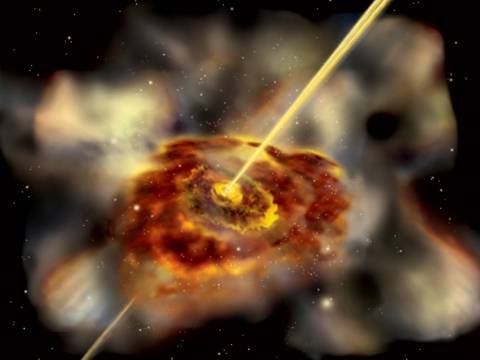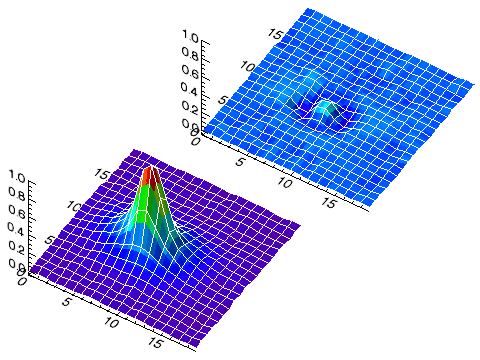Research interests:
- Active galactic nuclei at infrared and sub-mm wavelengths
- The dusty torus in active galactic nuclei
- Variability of active galactic nuclei, reverberation mapping
- High angular resolution imaging and spectroscopy
- Optical and infrared interferometry
- Adaptive optics
- Linguistics and phonetics (to some degree :-)
Observing the nuclear gas and dust in active galactic nucleiActive Galctic Nuclei (AGN) are the extremely luminous centres of galaxies. Often they release more energy than all the stars of the respective galaxy. The energetic phenomena are produced by the accretion of matter onto a SuperMassive Black Hole (SMBH), that is, a black hole with a mass of more than 105 solar masses. Most, if not all galaxies harbour such a supermassive black hole at their centre. Because of the large amounts of energy set free, active galactic nuclei are thought to play an important role in the formation of galaxies and hence in the formation of the universe as we observe it today.  Artist's impression of an AGN, where a supermassive black hole is hidden in a disk of gas and dust.
Artist's impression of an AGN, where a supermassive black hole is hidden in a disk of gas and dust.CREDIT: Sonoma State University - Aurore Simonnet Apart from the supermassive black hole and the accretion disk surrounding it, warm molecular gas and dustIn the context of astrophysics, dust refers to silicates and graphite grains with sizes of ~ 0.1 µm, i.e. to "sand and soot". are important constituents of AGN. The gas and dust are heated by the radiation from the accretion disk and they are located in a toroidal structure which surrounds the central engine like a doughnut. This so-called "dusty and molecular torus" is the reservoir of matter for feeding the supermassive black hole and it contains the obscuring material which leads to different manifestations of AGN. According to the unified scheme of AGN, the dusty torus (or a warped disk) is thought to be responsible for the dichotomy of type 1 (torus face-on, direct line of sight towards the central engine) and type 2 (torus edge-on, obscuring the central engine) AGN. It is, however, still uncertain if type 1 and type 2 AGN really possess identical tori and whether the outflows and the ionisation cones are collimated by the torus or by other phenomena. Furthermore, there are several theories explaining the geometrical thickness of the torus and is not yet clear how the torus is connected to the fuelling of the black hole. The dusty tori are small: they have sizes of a few parsec in the closest galaxies. That corresponds to angular sizes on the order of 10 mas and smaller, that is, roughly the size of a human hair seen from 1 km distance. The dust at the inner edge of the torus reaches temperatures of 1600 K (T ~ 1300 °C, pretty much red-hot), while the majority of the dust in the body of the torus is warm (T ~ 300 K, which corresponds more or less to room temperature). To investigate the properties and the physics of the dust distribution, observations thus have to be carried out at very high angular resolutions and in the thermal infrared. Currently, the necessary resolution can only be achieved by interferometric means, that is, by combining the light of two telescopes located several tens of meters apart to produce an interference pattern ("fringes"). For my studies, I make use of the Very Large Telescope Interferometer (VLTI) of the European Southern Observatory (ESO) in the Atacama desert in Chile, using interferometric instruments such as MIDI, PIONIER, GRAVITY and more recently also MATISSE. Interferometry in the infrared will leave certain questions concerning the nuclear material in AGN unanswered, e.g. concerning the kinematics and the chemistry of the material. These questions can be addressed by observations of molecular line emission at sub-mm wavelengths (wavelengths a little shorter than one millimeter). The line emission comes from the molecular gas in the torus, such as CO (carbon monoxide), CS (carbon sulfide), H2O (water), HCN (hydrogen cyanide) or HCO+. With the Atacama Large Millimeter/submillimeter Array (ALMA), I am studying the gas kinematics using in order to discern various scenarios for the physics supporting the torus structure. And from the relative strengths of different molecular transitions, one can infer the physical state of the gas in the torus. Complementary to these main observing projects, I make use of photometric monitoring, adaptive optics assisted imaging and spectroscopy to address the open questions related to the central regions of active nuclei. |
PhD thesis: "Mid-infrared interferometry of nearby Active Galactic Nuclei"Under the supervision of Prof. Dr. Klaus Meisenheimer, I analysed interferometric data of four active galactic nuclei obtained with the mid-infrared interferometer MIDI at the Very Large Telescope Interferometer.
Sketch of the dusty torus in the Circinus galaxy.
The primary target was the Circinus galaxy, a prototype Seyfert 2 galaxy. The interferometric data revealed a highly elongated, warm emission region (T > 390 K) with a size of 0.4 pc surrounded by an extended, almost round and cooler emission region (T ≤ 300 K) with a size of 2.0 pc. I was able to show that indeed a geometrically thick dust distribution exists in the nucleus of the Circinus galaxy. In a second object, Centaurus A, the observations revealed the existence of two components in the inner parsec of this galaxy: a resolved component and an unresolved core. The resolved component was interpreted as a disk perpendicular to the jet axis, while the unresolved core seems to have a synchrotron spectrum and hence can be identified with the footpoint of the jet. The fainter sources I worked on, MCG-05-23-01 (Sy 2) and Mrk 1239 (Sy 1), were only marginally resolved in the data that were available at the time of my thesis. To learn more on my work for my PhD and to download my thesis, look at the dedicated PhD thesis page. |
Diploma thesis: "PSF Analysis for the NACO Adaptive Optics System" Comparison of the original profile of a star observed with NACO and the residual after subtraction of a model PSF.
Comparison of the original profile of a star observed with NACO and the residual after subtraction of a model PSF.In my diploma thesis, I developed an analytical model for the point spread function (PSF) of the NACO adaptive optics system at ESO's VLT observatory in Chile. First, I analysed the properties of the NACO data and the variations of the point spread function. I placed special emphasis on spacial variations and anisoplanaticity effects. Then I created a first order analytical model of the PSF. Because of the high degree of complexity of an adaptive optics system and the instability of its PSF, the model has only limited capabilities for prediction of the form of the PSF. In a science application, I demonstrated the possibilities by using the PSF model in the analysis of the active nucleus of NGC 1097. An overview on the results of this work can be found in this short article. |
